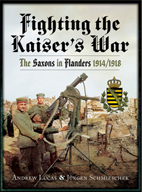This book is the magnum opus of Chris Dale, author of the excellent German Colonial Uniforms website and co-author of Osprey MAA 490: Imperial German Colonial and Overseas Troops 1885–1918. Having recently made his acquaintance (alas only online due to our current common predicament), I have also learned that he is somewhat of a renaissance man with many other strings to his bow. The most interesting of these for most of readers will be his Youtube channel Chris Dale's Military Museums, which unfortunately for him was launched immediately prior to the outbreak of the ongoing pandemic.

The volume's scope is clearly set out in its title - the traditions (including previous titles and 'genealogy') and uniforms of every German infantry regiment and Jäger battalion. The emphasis is very much on the 'colourful' pre-Feldgrau era, going back as far as the Seventeenth Century in describing the origins of the first recorded ancestor formations of the oldest units. Nevertheless the WW1 history of each unit covered is neatly summarised in its individual entry, and the development of Feldgrau uniforms described. It should be noted that the coverage is strictly limited to units which existed prior to WW1, and does not attempt to address the provenance of the vast number of new war-raised formations, no doubt for the sake of the author's sanity! In my opinion this is not really a problem, as that exceedingly complex and migraine-inducing subject has been more than adequately addressed by Hartwig Busche's 'Formationsgeschichte der deutschen Infanterie im Ersten Weltkrieg 1914-1918'.
The book begins with a concise history of the wars involving the German states from the Seventeenth Century onwards, culminating in the wars of unification which produced the final Prussian-dominated system of military organisation and nomenclature which the author then proceeds to describe with admirable succinctness and clarity. After these necessary preliminaries the regiments and battalions are then described in the conventional order (Prussian Garde infantry, line infantry, Bavarian infantry, Jägers) with anything from a paragraph to several pages per unit depending on the complexity of its traditions and uniform distinctions. Each series of units with a common background (such as the original Saxon regiments 100-108) is preceded by an additional introduction. The author has evidently taken great pleasure in unearthing charming idiosyncrasies such as regimental nicknames to add colour to his descriptions. Illustrations include colour photos of every variation of Pickelhaube and Tschako, numerous black-and-white period photographs, a few historic paintings of the earlier conflicts and a comprehensive set of colour plates showing the helmet, shoulderstrap and cuff for every single one of the featured units. Curiously there is no page numbering, but as a reference book with a logical and intuitive structure this is not a problem - in fact, I didn't even notice it until I came to write this review!
In conclusion, this is a convenient and thorough single-volume English-language reference to a subject otherwise covered in huge multi-volume German-language works of limited affordability and portability. One of its most intriguing features from an author's point of view is that it lacks a conventional publisher - Chris has elected to sell the book directly through Amazon, who print it on demand as a handsome 254-page softback volume. The print quality is in no way inferior to what one would expect from a conventional publisher, and it features an ISBN barcode on the back for retail sale. Whether this means that it will also be available through bookshops remains unclear, but I will be interested to find out. Surprisingly no electronic edition is currently offered, but I expect that this will change if there is sufficient demand from those who use Kindle or other e-readers.
Buy it here: https://www.amazon.co.uk/Traditions-Imperial-German-Infantry-Regiments/dp/B08SP2PK2V





